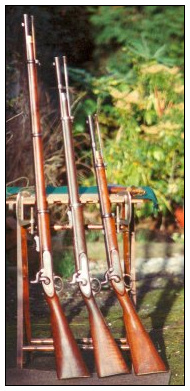You are here: Home > Firearms > British Military Longarms > Enfield
Written by: W.S. Curtis
Introduction > Rifle > Equipment > Ammunition > Shooting > Cleaning > Bedding
“There are persons who say that Rifle-shooting is a gift, and that a man, to become noted in the art, must be born a shot. I must be allowed, however, to say that I do not agree with them; for I believe that any man, with good health and sight, may by steady perseverance become the best shot…” – Captain Heaton, 1864.

The family of British Service Rifles and Carbines introduced during the 1850’s and 1860’s in 0.577 calibre marked the culmination of the soldiers’ muzzle loading firearm. This article does not attempt to deal with the historical aspects of these arms but merely to cover their modern use by enthusiasts. Their history has been almost completely covered by Dr. Christopher Roads in his excellent ‘The British Soldier’s Firearm 1850 -1864,’ (first published in 1964 and in a new edition by R&R Books in 1994). Pictured right are: Enfield rifles – Long, Short, and Artillery.
It has to be assumed that the person wishing to shoot these arms can show that he is a competent shot with rifles that are already established as being accurate. The techniques of target shooting will not, therefore, be discussed here. Many times over the past forty five years, the author has come across people who can only be summed up in the words of the immortal John Jorrocks as “good shooters but bad hitters”. It is only too apparent that to suggest that a person is not a good shot is tantamount to saying that he is not a good driver and grave offence can result. Nevertheless, the point has to made that the most accurate rifle in the world cannot be made to shoot a good group by anyone who is not already a good shot. Those who come to muzzle loading without having served an apprenticeship with more modern arms have nothing to measure themselves against and when their muzzle loading accuracy is bad, they tend to blame the arm or the load.
There is also the type who is convinced that somewhere there is the perfect load which will enable him to put every shot in the same hole at 100 metres. This chap, often an amateur engineer, will design and make endless series of bullet moulds, searching for that ultimate Holy Grail which he knows can be achieved if only he puts his mind to it. He is completely unimpressed by the marksman alongside him who puts in a score in the high nineties, using nothing but bullets from the standard Lyman #575213 mould, while he is treating his target to what seems like a load of buckshot.
The author hopes that these notes intended for the guidance of the newcomer to that superb rifle, the Enfield, will prove of assistance and that, perhaps, there may even be a useful hint to the more experienced.
W.S. Curtis
Note: W.S. Curtis is a past Vice President of the Muzzle Loaders Association of Great Britain and was the holder of the World Record in the Minié Rifle Class from 1972 to 1980.